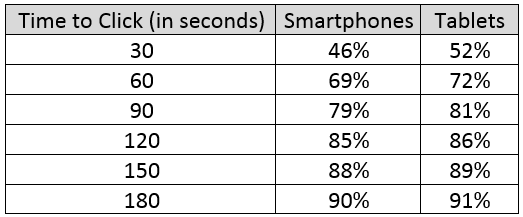The Shelf Life Of A Mobile Ad: Shorter Than You May Think
When a user loads a webpage, they aren’t doing so with the intent of clicking on an ad. Yet, millions and millions of users do just that every single day. However, this isn’t just a numbers game — intelligent marketers (like those who are reading this article) are looking to get the most out of […]
When a user loads a webpage, they aren’t doing so with the intent of clicking on an ad. Yet, millions and millions of users do just that every single day.
However, this isn’t just a numbers game — intelligent marketers (like those who are reading this article) are looking to get the most out of their advertising spend by targeting the right users in the right way at the right time. But even when an ad is shown based on any number of criteria, what’s its proverbial shelf life for that user? Two seconds? One minute? Five minutes?
Within this article, we’ll be analyzing a week’s worth of activity on the Chitika ad network to quantify this question. We then break out the patterns demonstrated by smartphone and tablet user bases, along with how these differ by operating system.
As a note, these data are specifically garnered from millions of smartphone and tablet ad clicks originating from within the U.S. and Canada between July 8 and 14, 2014.
Let’s begin by examining the time-to-click patterns of the continent’s smartphone users:

While the highest percentage of total clicks comes at around the 15 second mark, let’s place our main focus on the overall pattern of click activity over time rather than one single data point. In this context, you can see that close to 85% of total ad clicks occur within the first two minutes after a user loads a webpage on their smartphone; the 90% mark is crossed a full minute later.
In short, if your ad doesn’t receive a click within the first two minutes after it displays, it’s very unlikely that it will receive a click at all. This pattern is nearly mirrored within the tablet ecosystem:

That early peak in usage is more dramatic among tablet users but the subsequent fall is steeper. As such, 50% of all tablet clicks occur within the first 30 seconds of loading a page — roughly 6 percentage points higher than the share observed from smartphone users. But the differences between the user bases slowly diminish leading up to the two-minute mark, where they are nearly identical at roughly 85%.
To illustrate this further, the table below shows cumulative click percentages at given timeframes after a webpage has loaded:

In both cases, the vast majority of ad engagement occurs relatively soon after a user loads a page, with rates substantially declining after that initial time period. These patterns carry over when examining North American Android and iOS click activity:

As compared to Android, iOS users exhibit a slightly higher peak of click activity within the first 30 seconds of loading a page, but that rate drops somewhat more dramatically after that time. However, just like the previous smartphone and tablet data sets, overall trends remain remarkably similar:

The implications for advertisers are numerous, particularly when it comes to increasing cost effectiveness of a given campaign run on mobile. If the main goal is to get the user to click on the ad and hopefully take an action on the subsequent page, these statistics support the fact that after an ad has been displayed on the page for one to two minutes, its remaining value in terms of gaining a conversion is greatly minimized.
With current technology enabling a more dynamic ad environment, these data are ammo for marketing practitioners looking to maximize their investment in mobile.
If you’re an advertiser, it’s imperative that your inventory be shown within that initial window — perhaps taking advantage of newer ad formats that make the ad viewable precisely when the page is loaded, with no necessary scrolling from the user (e.g., adhesion banners, sliders, etc.).
Additionally, if an ad hasn’t been clicked within that one to two minute time period, collapsing or refreshing the entire unit with new inventory is a viable option that in most cases should not substantially impact the campaign’s reach or effect on the user themselves.
The time at which a given user’s attention turns to the ad may vary significantly based on the ad content, placement, or simply user preference, among other factors; but, the data clearly indicate that there are real patterns as to when North American mobile users are most and least likely to engage with ads.
Particularly with the functionality and granularity now present within the online advertising ecosystem, time-to-click should be a real consideration when developing campaign strategy and tactics.
Contributing authors are invited to create content for MarTech and are chosen for their expertise and contribution to the search community. Our contributors work under the oversight of the editorial staff and contributions are checked for quality and relevance to our readers. MarTech is owned by Semrush. Contributor was not asked to make any direct or indirect mentions of Semrush. The opinions they express are their own.
Related stories